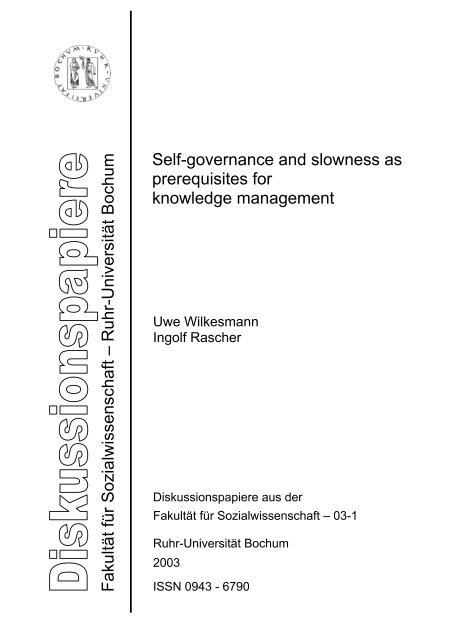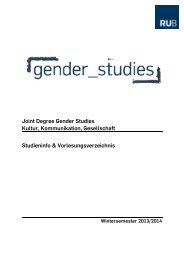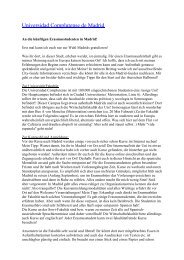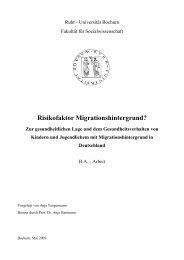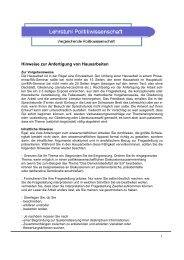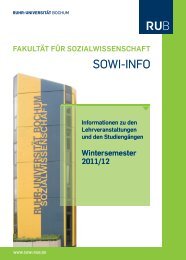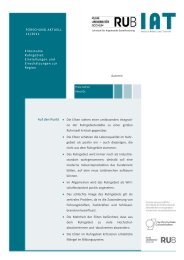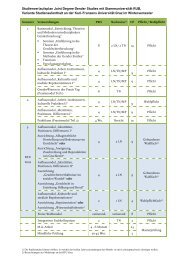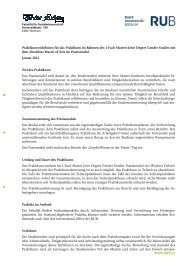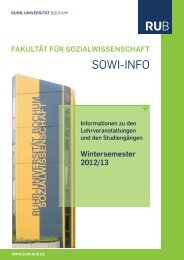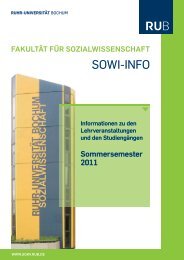View - Fakultät für Sozialwissenschaft der Ruhr-Universität Bochum
View - Fakultät für Sozialwissenschaft der Ruhr-Universität Bochum
View - Fakultät für Sozialwissenschaft der Ruhr-Universität Bochum
Create successful ePaper yourself
Turn your PDF publications into a flip-book with our unique Google optimized e-Paper software.
Fakultät für <strong>Sozialwissenschaft</strong> – <strong>Ruhr</strong>-Universität <strong>Bochum</strong><br />
Self-governance and slowness as<br />
prerequisites for<br />
knowledge management<br />
Uwe Wilkesmann<br />
Ingolf Rascher<br />
Diskussionspapiere aus <strong>der</strong><br />
Fakultät für <strong>Sozialwissenschaft</strong> – 03-1<br />
<strong>Ruhr</strong>-Universität <strong>Bochum</strong><br />
2003<br />
ISSN 0943 - 6790
Wilkesmann/Rascher self-governance and slowness page 1<br />
Diskussionspapiere aus <strong>der</strong> Fakultät für <strong>Sozialwissenschaft</strong><br />
<strong>Ruhr</strong>-Universität <strong>Bochum</strong><br />
Self-governance and slowness as prerequisites for knowledge management<br />
von<br />
Uwe Wilkesmann und Ingolf Rascher<br />
Diskussionspapier Nr. 03 – 1<br />
Juni 2003<br />
Korrespondenzanschrift:<br />
PD Dr. Uwe Wilkesmann - Ingolf Rascher<br />
<strong>Ruhr</strong>-Universität <strong>Bochum</strong><br />
Fakultät für <strong>Sozialwissenschaft</strong><br />
Sektion Sozialpsychologie und Sozialanthropologie<br />
GB 04 / 146<br />
D-44780 <strong>Bochum</strong><br />
Telefon 0234 - 32 25416<br />
Die Diskussionspapiere aus <strong>der</strong> Fakultät für <strong>Sozialwissenschaft</strong> <strong>der</strong> <strong>Ruhr</strong>-Universität <strong>Bochum</strong><br />
werden von <strong>der</strong> Fakultät für <strong>Sozialwissenschaft</strong> herausgegeben. Die inhaltliche Verantwortung<br />
für die Beiträge liegt bei den Autoren und nicht bei <strong>der</strong> Fakultät. Die Papiere können bei<br />
den jeweiligen Autoren angefor<strong>der</strong>t werden.<br />
Die Liste aller Papiere finden Sie auf den Internet Seiten <strong>der</strong> Fakultät unter<br />
http://www.ruhr-uni-bochum.de/sowi/forschung/dkpaper/liste98.htm<br />
ISSN 0943 - 6790<br />
1
Wilkesmann/Rascher self-governance and slowness page 2<br />
Uwe Wilkesmann and Ingolf Rascher<br />
Self-governance and slowness as prerequisites for<br />
knowledge management<br />
Paper for the 19 th EGOS Colloquium in Copenhagen,<br />
Subgroup 33 “New Conditions for Managing Knowledge”<br />
July 2003<br />
Uwe Wilkesmann<br />
Ingolf Rascher<br />
<strong>Ruhr</strong>-University <strong>Bochum</strong><br />
Faculty of Social Science<br />
GB 04/146<br />
44780 <strong>Bochum</strong><br />
Germany<br />
Uwe.Wilkesmann@ruhr-uni-bochum.de<br />
www.Uwe-Wilkesmann.de<br />
Ingolf.Rascher@ruhr-uni-bochum.de<br />
www.Ingolf-Rascher.de<br />
2
Wilkesmann/Rascher self-governance and slowness page 3<br />
Uwe Wilkesmann and Ingolf Rascher<br />
Self-governance and slowness as prerequisites for knowledge<br />
management<br />
The aim of this paper is to show that self-governance is the only way to create knowledge in<br />
organizations. We will show that knowledge can only be developed and preserved by selfgovernance.<br />
As self-management is not a natural process, it needs structures to support the<br />
development of this kind of action. Management is only able to create these structures at a<br />
second level. Thus a distinction between two different levels has to be made: the level of<br />
performance and the structural level. The latter determines whether a certain form of action is<br />
either supported or destroyed. 1 The management, however, is not able to create these<br />
structures alone, it is a negotiation process between the powerful actors and groups. In<br />
Germany, one of these powerful groups in the internal organizational negotiation process is<br />
the works council.<br />
First of all it is necessary to define the terms knowledge management, self-governance, and<br />
slowness.<br />
Knowledge management can be defined by the three following criteria:<br />
1. The development of new knowledge,<br />
2. the exchange and storage of data,<br />
3. the negotiation process which is to create those structures that support self-governance<br />
for the development of new knowledge and the free exchange of information.<br />
The most important task of knowledge management is to develop new knowledge. Therefore<br />
certain forms of learning are needed and, at the same time, an exchange of those pieces of<br />
information which are necessary for the development. We will show that the development of<br />
knowledge and an exchange of data is only possible un<strong>der</strong> certain working conditions.<br />
Self-governance can be defined as a structure which sustains self-management. Slowness is<br />
defined as self-management of time. Thus it is a dimension of self-governance and we show<br />
that it is an important factor for intrinsic motivation.<br />
1<br />
For the relationship between action and structure see Giddens (1984) or Coleman (1990)<br />
3
Wilkesmann/Rascher self-governance and slowness page 4<br />
1. Development of new knowledge<br />
How is it possible for companies to create new knowledge? First of all it is a fact that<br />
individuals learn in organizations 2 . Nevertheless, for the whole organization it is irrelevant<br />
whether Mrs. Smith learns how to use the new software program or not. If she does, Mrs.<br />
Smith has created new knowledge for her own use, but not for the company. The classical<br />
psychological theories cannot explain how new knowledge is developed. They merely explain<br />
how a person reaches a defined knowledge goal. In collective learning situations, however, it<br />
is possible that new knowledge occurs, because the contribution of one person can be linked<br />
with that of another one and hence create a new perspective which could not occur in a single<br />
learning situation. Most of the relevant knowledge in a company cannot be attributed to one<br />
single person. For example, developing a new product, reengineering the company or creating<br />
new working structures is not the work of a single employee. In the case of knowledge<br />
development the employees have to solve complex problems. Complex problems are defined<br />
as problems (Wilkesmann 1999)<br />
1. which could not be solved with the information of only one person,<br />
2. which do not have criteria for a correct solution,<br />
3. which lack a well-known solution path and<br />
4. which need the development of new adaptation steps.<br />
Complex problems can only be solved in collective learning situations. Collective learning is<br />
defined as a situation in which all participants exchange different perspectives (that means<br />
data) which are afterwards integrated into one solution. Therefore input and process variables<br />
are relevant. An input variable is, for example, my knowledge (in this case data is<br />
exchanged), the process variable is the group-interaction. A common example is a projectgroup.<br />
From the employee’s point of view knowledge is power. If I give all my information to<br />
other people, I lose power in relevant bargaining situations. Why should I give my knowledge<br />
to other people? My knowledge is my power-resource. Despite all cheap talking about<br />
2<br />
Individual learning is described in the psychological concepts of classical conditioning,<br />
operant conditioning and social learning. For organization studies only the two latter<br />
concepts are relevant. In a classical hierarchy the superior has to evaluate the inferior. If I<br />
want to make a career, I better do what my boss wanted, despite of what I think about his<br />
assignments. Thus learning routines will be established. This is not only the case in a<br />
classical hierarchy but also with all selective incentives. For example pay by performance<br />
will produce the same learning routines. If there exists an incentive for the number of<br />
insurance policies I have sold, the only action that counts is selling a large number of<br />
insurance policies, nothing else, neither quality nor information or communication with<br />
the customer. Individual learning only solves simple problems.<br />
4
Wilkesmann/Rascher self-governance and slowness page 5<br />
knowledge management, I’m not interested in sharing my knowledge. I expect rewards for<br />
my willingness to share my knowledge.<br />
A company's survival is dependent on the development new knowledge, but from the point of<br />
view of each employee it is rational that other employees pay for the costs of creating<br />
knowledge. From "ego's" perspective it is rational to invest nothing in the creation of<br />
knowledge, if "alter" freely ren<strong>der</strong>s his information and is highly engaged in developing new<br />
knowledge. Thus when all others are cooperating, ego declines to help. The first condition of<br />
a n-person-prisoner-dilemma is fulfilled [D (n) > C (n) ] 3 . The second condition [C (n-1) > D (0) ] is<br />
fulfilled as well, because ego is not able to produce profit, if nobody develops new<br />
knowledge. The company will drop out of the market and ego will lose his job. Thus it is<br />
rational for ego to cooperate, if n-1 employees cooperate, too. As a result, the third condition<br />
[D (n) > D (0) ] is fulfilled as well, because the loss caused by the defecting of all employees in<br />
the process of creating new knowledge is greater than when only a few employees are<br />
cooperating.<br />
1.1 How is it possible to overcome the prisoner’s dilemma?<br />
Traditionally, there are two ways to overcome the prisoner’s dilemma: either a third actor<br />
rearranges the game by placing selective incentives (e.g. Hobbes), or the cooperative strategy<br />
is stabilized internally.<br />
In the case of knowledge development the prisoner’s dilemma cannot be overcome by<br />
selective incentives (Osterloh/Frost/Rota 2001). The basic problem is that the development of<br />
new knowledge cannot be perceived from an external point of view. If a third actor is not able<br />
to monitor the process, he will not offer a reward with selective incentives. The second reason<br />
is the problem of multiple tasking. In working processes with complex problems all<br />
employees have to fulfil a lot of tasks. Every selective incentive rewards only one task. A<br />
rational actor will then only complete that single task, all other tasks will be neglected<br />
(Frey/Osterloh 2002). On the other hand it is not possible to assign a lot of incentives. It is too<br />
complex and every action will then be rewarded.<br />
3<br />
The N-individuals-prisoner's dilemma is defined by the following three conditions:<br />
(1) D (n) > C (n)<br />
(2) C (n-1) > D (0)<br />
(3) D (n) > D (0)<br />
D and C are Ego's chosen strategies (defection or cooperation). The number of<br />
cooperative individuals is given in brackets. The inequations reflect the utility relations<br />
from Ego's point of view.<br />
5
Wilkesmann/Rascher self-governance and slowness page 6<br />
There are two ways to stabilize the cooperative strategy internally: by social norms and by<br />
intrinsic motivation.<br />
A group can reward cooperative action, if the social group norm supports cooperative action<br />
(second-or<strong>der</strong>-free-ri<strong>der</strong>-problem; see Heckathorn 1989, 1993, 1996). Thus self-governance is<br />
an important solution to the prisoner’s dilemma. Therefore a group requires monitoring and<br />
sanctioning capacity. The ability to observe others has to be increased by creating groups with<br />
a small number of group members. Only in a group with up to 7 or 8 members everyone can<br />
monitor the others. If one member neglects his contribution, all the others feel the deficit,<br />
because it is a common production. The sanction capacity is influenced by two variables: on<br />
the one hand by the number of people carrying out sanctions and on the other hand by power<br />
differences.<br />
1. The more defective actions are sanctioned by group members, the more the value of social<br />
norms is increased. There is also a second way to overcome the second-or<strong>der</strong>-free-ri<strong>der</strong>problem.<br />
Only one individual is required to punish the defector. This person can be<br />
rewarded by all the others. This method is cheaper than the one which provides a<br />
punishment of the defector by all members (Coleman 1990: 283).<br />
2. Coleman defines 'power' as an interaction category: "The power of an actor resides in his<br />
control of valuable events. The value of an event lies in the interests powerful actors have<br />
in that event" (Coleman 1990: 133). Karen Cook expands this definition and includes the<br />
network structure, especially the local scarcity of a resource at a certain position in the<br />
network (Cook 1977; Yamagishi/Gillmore/Cook 1988; Cook/Whitmeyer 1992) 4 . The<br />
scarcity of a resource depends on the supply of the resource in the network – it is not only<br />
dependent on the demand. Valuable goods in companies are e.g. knowledge, skills,<br />
incentives or the control over the company's staff. If there exists a great power difference<br />
between the actors, a group norm could be easily sanctioned by the powerful actors, but<br />
the costs for leaving and objecting decrease compared to the low powerful actors. If the<br />
low powerful actor is punished all the time, his costs to leave will decrease. At a certain<br />
4<br />
"(1) In networks that consist of negative connections alone and in which resources do not<br />
flow beyond immediate exchange partners, the availability of resources from alternative<br />
exchange relations determines the distribution of power. ... (2) In networks consisting of<br />
positive connections alone, the local scarcity of resources determines the distribution of<br />
power. The local scarcity is, in turn, determined jointly by the total or aggregated supply<br />
of resources in the network and the distance of each point from the source points. (3) In<br />
mixed networks, in which both positive and negative connections are involved, the negative<br />
connections determine the total supply levels of the resources introduced into<br />
positively connected subnetworks, and these global scarcity levels (together with the<br />
6
Wilkesmann/Rascher self-governance and slowness page 7<br />
point it is even easier for him to find a new group than to stay in the first group. A further<br />
reason for not having a great power difference between the actors is connected to the first<br />
level of the dilemma. It would not be possible to solve the dilemma of collective learning.<br />
Even a powerful group member could not make the other employees release their<br />
information, if they do not want to. 5<br />
The structural conditions supporting a social group norm are: small groups and low power<br />
differences between the actors. These conditions support collective learning on the first (the<br />
production) level 6 . They only explain the domination of social norms, they do not give any<br />
information about the contents of the norm (whether the norm prescribes cooperative or<br />
defective action).<br />
The second way to overcome the problem of generating common knowledge is intrinsic<br />
motivation. Intrinsic motivation is defined by Heckhausen as follows:<br />
"Action is intrinsic if the means (the act) thematically corresponds to its ends (the action<br />
goal); in other words, when the goal is thematically identical with the action, so that it is<br />
carried out for the sake of its own objectives. For example, achievement behavior is intrinsic<br />
if it is engaged in merely to accomplish a desired outcome, because it solves a problem or<br />
leads to a self-evaluation of competence. Here, the outcome, a particular accomplishment, is<br />
not a means toward some other nonachievement-related end." (Heckhausen 1991: 406)<br />
If all actors have intrinsic motivation, there is no prisoner's dilemma. (Wilkesmann 1994).<br />
While the expenses, which were necessary to work out solutions for the given problems, have<br />
been registered as costs in the original prisoner's dilemma situation, these do not appear as<br />
costs when the actors are motivated intrinsically. The solutions are found, because working is<br />
fun and the solution process is interesting. Therefore an actor, who is motivated intrinsically,<br />
does not deduct these expenses from his profit, but adds them up as an extra profit. As a<br />
result, the cooperation strategy becomes individually rational. Here, again, the actors'<br />
subjective perception transforms the starting matrix. (Kelly/Thibaut 1978).<br />
Taking into consi<strong>der</strong>ation that intrinsic motivation is not a selective incentive it is not possible<br />
to produce it directly. The only way is to arrange the structural prerequisites in a manner that<br />
intrinsic motivation might be stimulated. Work psychological research defines a positive<br />
correlation between freedom of action and intrinsic motivation. Freedom of action is defined<br />
5<br />
6<br />
distance of each point from the source points in those subnetworks) affect the distribution<br />
of power within the subnetworks." (Yamagishi/Gillmore/Cook 1988, S. 849/850)<br />
Another argument for stabilizing a social norm is the well-known shadow of the future<br />
(Axelrod 1984).<br />
The management has to structure project groups with that scope.<br />
7
Wilkesmann/Rascher self-governance and slowness page 8<br />
as work enrichment, to do a task from the beginning to the end, and to decide on the work<br />
schedule autonomously.<br />
Hackman and Oldham (1980) have analysed the relationship between five core dimensions<br />
and the occurrence of intrinsic motivation. The core dimensions are:<br />
1. skill variety: "The degree to which a job requires a variety of different activities in<br />
carrying out the work, involving the usage of a number of different skills and talents<br />
of the person." (Hackman/Oldham 1980: 78)<br />
2. task identity: "The degree to which a job requires completion of a "whole" and<br />
identifiable piece of work, that is, doing a job from beginning to end with a visible<br />
outcome." (Hackman/Oldham 1980: 78)<br />
3. task significance: "The degree to which the job has a substantial impact on lives of<br />
other people, whether those people are in the immediate organization or in the world<br />
at large."(Hackman/Oldham 1980: 79)<br />
4. autonomy: "The degree to which the job provides substantial freedom, independence,<br />
and discretion to the individual in scheduling the work and determining the procedures<br />
to be used in carrying it out." (Hackman/Oldham 1980: 79) In this sense slowness is<br />
part of the core dimension autonomy. Without autonomy in organizing one's schedule<br />
intrinsic motivation cannot appear.<br />
5. job feedback: "The degree to which carrying out the work activities required by the<br />
job provides the individual with direct and clear information about the effectiveness of<br />
his or her performance." (Hackman/Oldham 1980: 80)<br />
Hackman and Oldham distinguish three individual dispositions caused by different attribution<br />
processes: knowledge and skill, growth need strength, and context satisfaction. If employees<br />
have these individual dispositions and if they work in one of the situations defined above, it is<br />
very likely that they will develop intrinsic motivation. If all group members are intrinsically<br />
motivated, the prisoner’s dilemma does not appear (Frey/Osterloh 2002).<br />
The core dimensions of Hackman and Oldham describe a self-management structure which is<br />
a form of self-governance. But creativity will only occur, if also the time management is<br />
controlled individually. Creativity is not possible un<strong>der</strong> pressure of time. A very tight<br />
schedule will be perceived as a selective incentive by which the superior wants to exert<br />
control. Therefore time pressure will be perceived as a controlling method and thus produces<br />
a crowding out effect of intrinsic motivation. 7 The actors will reduce their intrinsic<br />
7<br />
Frey (1997) recapitulate un<strong>der</strong> which conditions the crowding out effect appears: "(1)<br />
External interventions crowd out intrinsic motivation if the individuals affected perceive<br />
8
Wilkesmann/Rascher self-governance and slowness page 9<br />
motivation. Thus individual time-management has to be added to the core dimensions. It is a<br />
prerequisite for intrinsic motivation.<br />
The generation of new knowledge is only one major function of knowledge management. The<br />
following chapter deals with its second function and its structure of self-governance.<br />
2. Storage and exchange of data<br />
The second function of knowledge management is the storage and exchange of data. If every<br />
employee is to use the new knowledge, it will have to be stored and made accessible for<br />
everyone. Different types of preservation and internal channels of communication exist:<br />
report papers, dossiers, personal memory, but also newspapers, bulletin boards and routines.<br />
Here a current channel is analysed, the database.<br />
2.1 The dilemma of data storage<br />
The storage of knowledge is a prisoner’s dilemma. 8 We characterize it as a two person<br />
dilemma. The cooperative strategy illustrated below is to put data in the database. The<br />
defective strategy is not to put data in the database (fig. 1). Another defective strategy is not<br />
to put all the data in, so that the user is not able to un<strong>der</strong>stand the document without additional<br />
information from the author.<br />
8<br />
them to be controlling. In that case, self-determination, self-esteem and the possibility for<br />
expression suffer, and the individuals react by reducing their intrinsic motivation in the<br />
activity controlled. (2) External interventions crowd in intrinsic motivation if the<br />
individuals concerned perceive it as supportive. In that case, self-esteem is fostered, and<br />
individuals feel that they are given more freedom to act, thus enlarging selfdetermination."<br />
(Frey 1997: 18)<br />
Every player has got two strategies: either to cooperate with the other player or not to<br />
cooperate. The first strategy is called cooperation (C), the second defection (D). The<br />
payment at the left shows the benefit for player I, the one at the right for player II. The<br />
letters can be replaced by various numerical values, which only have to be sufficient for<br />
the following or<strong>der</strong>: T > R > P > S and R > (T+S)/2. The dilemma is that the individually<br />
rational strategy is defection. If both players choose this strategy, then the solution will be<br />
P/P, which is pareto-suboptimal. Hence to act individually rational does not lead to a<br />
collectively rational result. In or<strong>der</strong> to produce this, a method has to be found which<br />
makes the cooperative strategy to be individually rational and brings about the result R/R.<br />
This happens when the payment conditions are in the same or<strong>der</strong> as those of the<br />
assurance-game: R > T > P > S.<br />
9
Wilkesmann/Rascher self-governance and slowness page 10<br />
employee II<br />
employee I puts in does not put in<br />
puts in R / R S / T<br />
does not put in T / S P / P<br />
Fig. 1: PD of storage knowledge in a database<br />
The reward is: T > R > P > S and R > T+S/2<br />
If both players put data in the database, they can use it mutually. Both of them get new<br />
information, thus they receive a reward of R. If employee I does not put his data in the<br />
database, but employee II does, the first one receives the highest reward (T) and hence he is a<br />
free-ri<strong>der</strong>: he does not share his knowledge in or<strong>der</strong> to be able to use it in strategic bargaining<br />
situations to be quickly promoted and he will not spend time on putting data in. Moreover, he<br />
can use the information of employee II. Employee II receives the lowest reward (S), because<br />
he spent time on putting the data in, shared his knowledge with employee I and thus he loses<br />
his most important resource of power. Employee I, for example, could use the information of<br />
employee II in or<strong>der</strong> to create an important presentation for the board, which could push his<br />
career even further. If both players defect, the database won't work (P).<br />
The prisoner’s dilemma does not occur in every database. We have to distinguish between<br />
different types of databases. The following categories can be distinguished:<br />
1. technical database: Here, the data is necessary to control the production process. The<br />
production process will be structured by the data and no prisoner’s dilemma is to be<br />
expected. Despite the data is essential, the database in the case study is not up to date.<br />
2. service database: All users have to put data in voluntarily. The contents of the<br />
database could for example be: the results from project-groups; consulting experience<br />
and solutions, so that the same consulting process could be sold twice; urgent requests<br />
from sales personnel, whether a new customer solution exists or someone in a<br />
different country has developed anything similar; exchange of experience in<br />
newsgroups etc. The prisoner’s dilemma might occur with this type. The case study<br />
below will be an example for that.<br />
3. process database: Here, the data input does not take place voluntarily. The database is<br />
only used to monitor a project. All milestones and minutes are stored. Only the<br />
project-group members are allowed to use it. The prisoner’s dilemma will probably<br />
not occur.<br />
4. meta database: This type is only a technical solution, it’s a search machine which<br />
retrieves information from different databases, like yahoo on the internet.<br />
10
Wilkesmann/Rascher self-governance and slowness page 11<br />
5. yellow pages/skill database: This is a subtype of no. 2 (service database) which<br />
contains only personal data from all employees. It is possible to search for people with<br />
certain skills, which are needed, for example, to solve computer problems. The<br />
specific problem here is to choose which kind of personal information should be saved<br />
in the database. If the input of information is realized on a voluntary basis, the<br />
prisoner’s dilemma might occur.<br />
The prisoner’s dilemma of information saved in databases could be solved by intrinsic<br />
motivation and (sometimes) by external interventions.<br />
2.1 How to overcome the prisoner’s dilemma?<br />
2.1.1 Intrinsic motivation<br />
The first possible solution of the prisoner’s dilemma is intrinsic motivation (see Heckhausen's<br />
definition (1991) mentioned above). If intrinsic motivation is present, the prisoner’s dilemma<br />
will not occur. The cooperative strategy is dominant and it is fun to join the database and to<br />
put data in. The actor does not take into consi<strong>der</strong>ation possible rewards, he <strong>der</strong>ives benefit<br />
from his action. Intrinsic motivation is closely linked with small groups in an organization,<br />
which are organized by specific topics, skills etc. These are called 'communities of practice'<br />
(Lave/Wenger 1991). "A Community of Practice is a group of people who are linked together<br />
by a common ability or a shared interest, and consequently possess common practical<br />
experience, specialist information and intuitive knowledge. They share information,<br />
experience and insights and are supported by various tools" (Enkel/Heinold/Hofer-<br />
Alfeis/Wicki 2000: 87). Communities of Practice are necessary for creating an efficient<br />
bottom up implementation process. These communities belong to the Mode-2 science<br />
(Gibbons et al. 1994).<br />
Thus a database has to be planned and introduced by the help of knowledge communities.<br />
Otherwise the database won't be used because of wrongly anticipated needs.<br />
The following two hypotheses are a summary of the current discussion:<br />
H 1: The more scope the actors have, the more likely it is that intrinsic motivation arises.<br />
H 2: The more scope the actors have, the more the user cooperates.<br />
Employees can develop intrinsic motivation, even if their actions don’t support the goalachievement<br />
of the whole company, for they have different goals. The individual goals might<br />
not coincide with the company’s goal. The individual might have intrinsic motivation, but<br />
only reaching as far as his private preferences are reflected in his job. These actions are not<br />
11
Wilkesmann/Rascher self-governance and slowness page 12<br />
efficient for the company. Therefore external interventions are needed as well (Frey/Osterloh<br />
2002).<br />
12
Wilkesmann/Rascher self-governance and slowness page 13<br />
2.1.2 External intervention<br />
The management can intervene in the prisoner’s dilemma as a third actor. It might reward the<br />
cooperative strategy with an extra bonus X. The rewards for the cooperative strategy will be<br />
changed like this (fig. 2):<br />
employee II<br />
employee I puts in does not put in<br />
puts in R + X / R + X S + X / T<br />
does not put in T / S + X P / P<br />
Fig. 2: PD of storage knowledge in a database with external intervention<br />
The cooperative strategy will be dominant individually, if X ≥ T – R. And if X is added to the<br />
rewards R and S, an or<strong>der</strong> of rewards can be established: R > T > S > P. It is a mix of<br />
assurance and chicken game.<br />
In the company’s point of view it is also efficient to award a bonus, because the dilemma is<br />
overcome and all employees put their data in the database. The function of storage and<br />
exchange of data is fulfilled. The company does not reinvent the wheel. Knowledge is there,<br />
where it is needed. Not only the contributor ("giver of knowledge") has to be rewarded but<br />
also the re-user ("taker of knowledge"; see Gibbert/Jonczyk/Völpel 2000). The evaluation and<br />
monitoring process can be constructed in analogy to the evaluation process of the well-known<br />
internet auction company E-Bay.<br />
External rewards 9 could be books, mobile phones, and days off. But there are some problems<br />
with such selective incentives:<br />
1. They might produce a cycle of expectations (see Frey/Osterloh 2002). If I receive a<br />
reward of Z this year, I will expect a reward of Z + X next year.<br />
2. The problem of multi-tasking: "If a company pays its employees on the basis of<br />
certain targets which have to be achieved (e.g. sales and customer satisfaction) and the<br />
targets in question are different to a certain extent, as it is either easy or difficult to<br />
measure them (for instance, sales can be measured more easily and clearly than<br />
customer satisfaction), then extrinsically motivated employees will concentrate on<br />
9<br />
"Conversely, behavior is extrinsic when the means (action) and the ends (action goals) are<br />
thematically incongruent; when the goal is thematically different, and the action and its<br />
outcome constitute a means for bringing about a different kind of goal. The means<br />
character is merely external and essentially arbitrarily selected. For example, aggression<br />
is extrinsic if one attacks people not to do injury (that would be intrinsic) but to rob them.<br />
Aggression research calls this "instrumental" aggression, which should not be confused<br />
with actual (i.e., in our terms, intrinsic) aggression." (Heckhausen 1991: 406)<br />
13
Wilkesmann/Rascher self-governance and slowness page 14<br />
those areas which can be measured best. Activities which are less easily quantifiable<br />
will be neglected." (Frey/Osterloh 2002: 19)<br />
3. External interventions may not always enhance intrinsic motivation. Consi<strong>der</strong>ing the<br />
problem of the crowding-out effect (over justification; see Heckhausen 1991: 408),<br />
external interventions lower motivation. Extrinsic incentives might even destroy<br />
intrinsic motivation 10 .<br />
The following incentives are important and do not induce the crowding-out effect:<br />
• The social status (all other employees consi<strong>der</strong> you to be an expert)<br />
• The perception of usefulness (which belongs to the norm of reciprocity)<br />
Generally speaking selective incentives are only useful when the size of a database has<br />
reached a critical mass of documents. In other cases it is very likely that the problem of<br />
crowding-out will increase. Thus incentives have to be used very carefully.<br />
Our third hypothesis is:<br />
H 3: The external incentives "social status" and "perception of usefulness" enhance<br />
intrinsically motivated cooperative action.<br />
3 Case Study: Siemens' database ShareNet 11<br />
Now we want to present the database ShareNet, developed by Siemens ICN. Siemens<br />
Information and Communication Networks (ICN) provides networks and solutions for the<br />
internet of the coming generation – prerequisites for mobile business. With a basis of 220<br />
million connections in the network segment and more than 70 million connections of<br />
corporate clients Siemens is leading in the language and data network branch. ICN had a<br />
turnover of 9 billion Euro in the year 2000.<br />
10<br />
11<br />
The hidden costs of rewards are based on three psychological processes (Frey 1997: 16-<br />
17): Impaired Self-Determination: When people are intrinsically motivated, the focus of<br />
control shifted by external rewards from inside to the outside. They no longer feel<br />
responsible for themselves, but make the actor, who gives the rewards, responsible for the<br />
action. Impaired Self-Esteem: The recognition of an action of intrinsically motivated<br />
personnel could be destroyed by external rewards, because the rewards deny the primary<br />
motivation. The individual might get the impression that his / her original action was not<br />
good enough. Impaired Expression Possibility: External rewards might deprive one of the<br />
possibility to show one's intrinsic motivation to other employees.<br />
We want to thank Dr. Michael Wagner, Andreas Manuth (both ShareNet-managers) for<br />
their help, as well as the other members of the ShareNet project team and Heribert Fieber<br />
(works council chairman) and Peter Kloeber (member of the works council and chairman<br />
of the ADV-committee).<br />
14
Wilkesmann/Rascher self-governance and slowness page 15<br />
3.1 Data and Method<br />
The empiric survey described below was carried out in autumn 2001 and spring 2002. It<br />
consists of two parts: a preliminary phase combined with qualitative interviews, and a<br />
quantitative online-survey.<br />
The online-survey was addressing those users of the database who had an internet connection<br />
and who had access to the database. As the number of employees in major companies is<br />
varying to a very high degree, the number of users of the database cannot be determined<br />
exactly. During the time of the survey the database ShareNet could be accessed by<br />
approximately 8.500 employees. This is the number of people who got a password. This<br />
amount can be consi<strong>der</strong>ed to be the basic total of the survey. Those responsible, however,<br />
think that the number of active users is only thirty-five per cent.<br />
The first part of the online-questionnaire included professional and demographic criteria like<br />
sex, age, working area (subdivision), country, and duration of employment. Hence this part<br />
refers to the basic structuring criteria of those taking part. The third part of the survey<br />
includes questions concerning the evaluation of working with the database. Similar to the<br />
empiric study by Hackman and Oldham (1980) the five core dimensions are operationalized.<br />
Every dimension is found out individually through two or four evaluative questions. The<br />
operationalisation of the dimensions has been made in accordance with the Hackman and<br />
Oldham's (1980) questionnaire. Variations are due to the fact that Hackman and Oldham's<br />
questionnaire was to analyse a production situation. Here, the single items are referring<br />
directly to the work with the database. The dimensions were operationalized by the following<br />
items:<br />
Skill variety is operationalized in the dimensions of required knowledge and acquiring this<br />
knowledge by training (otherwise the actor would not recognize diversity or he would feel<br />
overemployed) in form of the following items:<br />
"I need a variety of specific knowledge and skills for my activities";<br />
"I was well trained with ShareNet".<br />
As this examination analyses a database and not a physical product, task identity concerning<br />
the development of the database and the responsibility for one assignment is operationalized<br />
by means of the following items:<br />
"I feel sufficiently involved in the development of ShareNet";<br />
"I feel responsible for my assignment";<br />
"I am involved in the efforts to improve ShareNet which affect my working place".<br />
15
Wilkesmann/Rascher self-governance and slowness page 16<br />
The dimension of task significance is divided into three areas – significance for the company,<br />
individually perceived significance <strong>der</strong>ived from a just payment, and the independence of the<br />
individually attributed significance through the colleagues' criticism (this is necessary,<br />
because task significance has to be connected with the work itself and it must not come from<br />
an external position, as it should not be an extrinsic incentive):<br />
"How significant or important do you consi<strong>der</strong> your position at ShareNet for the<br />
company";<br />
"I feel paid off fairly for my contribution to ShareNet";<br />
"My superiors or colleagues rarely give me feedback concerning the quality of my work".<br />
The employee's autonomy is operationalized through the given choices and a clear attribution<br />
of responsibility. The latter is particularly important as otherwise it might be possible that<br />
someone else tries to influence the decisions. The following items define this dimension:<br />
"I can decide to manage my tasks in a certain or<strong>der</strong>“;<br />
"I have a clearly defined job description";<br />
"I'm able to manage all activities which belong to my assignment to ShareNet".<br />
Slowness is a part of the dimension of autonomy. A very tight schedule which is not managed<br />
by the actor himself will be perceived as external control. A tight schedule which cannot be<br />
changed or planned by the actor reduces his scope of decision and action to a very high<br />
degree. As the meeting of the appointments is supervised, there is control all the time. Very<br />
often the employees' payment takes into consi<strong>der</strong>ation their customers' account; this method<br />
reflects the logic of the market in the organisation. The scope of autonomous decisions is<br />
limited consi<strong>der</strong>ably by this means ("Three customers have to be dealt with until Friday – no<br />
matter, how!"). Unfortunately, this dimension of autonomy has become evident only after the<br />
questionnaire had been developed; therefore it is not included.<br />
The dimension of feedback is operationalized by either feedback from the working process<br />
(similar to the case described above, the feedback must not come from other people, as it is an<br />
extrinsic incentive then) or goal orientation:<br />
"I am included in specifying goal-agreements."<br />
"Working with ShareNet shows me how well I did – independently of my co-workers' and<br />
superiors' feedback."<br />
The following questions in section IV are referring to information concerning the organisation<br />
structure. Four questions are to find out how the employees evaluate the hierarchical<br />
structures and the interdependence of passing on knowledge and a loss of power. An<br />
evaluation of the incentive system, which is part of working with the knowledge database, is<br />
16
Wilkesmann/Rascher self-governance and slowness page 17<br />
the subject of the following questions in part V. The focus lies on an analysis of how the<br />
incentive system effects the employees' motivation. A just wage system, support of intrinsic<br />
and extrinsic motivation and the interdependence of both kinds of motivation are important<br />
here. In addition, an evaluation of the cost-benefit relations in dealing with the knowledge<br />
database voluntarily is to be made. The effects of the incentive system on the dissemination of<br />
information and the teamwork are also part of the questionnaire.<br />
Extrinsic motivation is operationalized by means of two items concerning the effect of<br />
Shares:<br />
"For stronger motivation the Shares should be increased regularly."<br />
"Additional Shares encourage me to set higher goals."<br />
As it is difficult to ask directly for intrinsic motivation when data is passed on, it is asked for<br />
indirectly. It is operationalized through the crowding-out effect. Hence it is also easier to<br />
demarcate it from extrinsic motivation.<br />
"I believe that Shares motivate my colleagues to be more concerned about their own<br />
benefit."<br />
"If Shares are assigned, the superiors have better control over my performance."<br />
In addition, two items are used which describe both intrinsic and extrinsic motivation without<br />
any crowding-out effect. This is true when the employee earns praise ("Instead of giving<br />
Shares my superiors should let me know how satisfied they are with my performance") and<br />
when the Shares are taken, although they are not consi<strong>der</strong>ed to be necessary ("I am happy<br />
with receiving Shares as an additional reward, but however I do not find it necessarily to<br />
motivate me").<br />
In section VI the questions deal with the working situation in general. It is asked, whether<br />
there exist clearly defined profiles of qualification and work specifications. Also<br />
communication structures and employee-superior-relationships are at stake. In part VII of the<br />
online-questionnaire the participants of the survey have to evaluate knowledge management<br />
in general and in their company. The final part VIII contains short questions concerning<br />
working with the database. The participants have to state how long they have been working<br />
with the database and whether they received introductory training. Finally they have to make<br />
a general assessment of the quality of information which can be retrieved from the database<br />
and of its structure.<br />
The participants have seven different possibilities (based on the Seven-Likert-Scale) to<br />
answer these questions, from "I do not agree at all" (1), over "neutral" (4) to "I fully agree" (7)<br />
17
Wilkesmann/Rascher self-governance and slowness page 18<br />
(Diekmann 2000: 209). In or<strong>der</strong> to make it easier all the possible answers follow the same<br />
scheme.<br />
3.2 Results of the Interviews and of the Online-Survey<br />
The database is part of the corporation's sales department. It was developed because of the<br />
experience that a lot of knowledge exists in the sales departments all over the world, but<br />
nobody knows what kind of knowledge exists. Thus the employees very often had to do work<br />
twice before the database was introduced. Special offers, technical specifications or<br />
implementation strategies sometimes existed already, but they were developed a second or a<br />
third time, because the employees in charge did not know anything of the existing solutions.<br />
In or<strong>der</strong> to avoid this "wasting" of resources, the corporation introduced a staff department<br />
which then initiated the development of the database with the help of project organisation.<br />
From the beginning those employees who later became ShareNet-managers were invited from<br />
all over the world to different workshops, because the later users should take part in the<br />
conceptionalisation and implementation. Accordingly, planning and introduction were a<br />
participative process. 12<br />
In addition to a mere storage of documents which allows a free and voluntary input of<br />
documents following certain keywords, there existed 58 different discussion fora concerning<br />
specific organisational problems at the time of the survey. The database's function of "urgent<br />
request" is the function most frequently used. All the employees, especially sales managers<br />
when they have customers, are allowed to make urgent requests which are answered by their<br />
colleagues immediately. For example, a sales manager could ask whether it is possible at all<br />
to realize a technical specification which a customer wants or whether it has been developed<br />
already in another country.<br />
The database has got three characteristic features regarding the issues discussed here:<br />
1. A specific incentive system rewards the input of documents and questions.<br />
2. In addition to computer-based communication the knowledge community's face-toface<br />
communication is supported deliberately.<br />
3. A controlling instrument supervises the database's efficiency.<br />
(1) An incentive system has been developed in or<strong>der</strong> to make sure that enough data,<br />
information, and requests are put in, that an adequate amount of requests is answered and that<br />
the data is used. This incentive system is not only to reward the use of the database, but it is<br />
12<br />
For the importance of participation in knowledge management see Rascher/Wilkesmann<br />
2003.<br />
18
Wilkesmann/Rascher self-governance and slowness page 19<br />
also meant to enhance the evaluation of the quality of the stored documents and the answers<br />
to the urgent requests. A guideline regulates the assignment of credit points, "Shares".<br />
Generally speaking, everyone who answers an urgent request receives three Shares. The<br />
questioner can evaluate the quality of the answer by giving up to five additional Shares. At<br />
the time of the survey these were multiplied by two in or<strong>der</strong> to emphasize the importance of<br />
the qualitative evaluation. Up to 20 Shares can be assigned for the documents in the database.<br />
If one object is evaluated with zero Shares twice, it will be moved from the database into an<br />
archive. There it is still available. The author of the object will be informed about this<br />
measure. At a certain point in time all the Shares collected by one employee are converted<br />
into prizes. According to the number of Shares the following prizes are awarded: technical or<br />
economic literature, different new mobile phones, additional training offers and visiting a<br />
colleague/subsidiary with whom/which a lot of data was exchanged. In addition to the<br />
incentive of a vacation, face-to-face communication is to be supported. The extrinsic<br />
incentives are meant to increase the amount of data in the database to a critical level and to<br />
establish a mutual quality controlling. After the period un<strong>der</strong> investigation had ended the<br />
credit point system was abolished again. As a critical amount of data and users has been<br />
reached, the system is to be maintained by the intrinsic motivation of the users in the future.<br />
(2) In or<strong>der</strong> to support face-to-face communication a second instrument was introduced as<br />
well: those 10 to 15 employees who have used the discussion forum a lot will be invited to a<br />
three-day workshop. There they can continue to discuss the topics they are most interested in,<br />
but especially they are to meet in person in or<strong>der</strong> to build up confidence and to strengthen<br />
their interaction relationships. Thus relevant discussions are supported and the knowledge<br />
communities are stabilized.<br />
(3) A controlling instrument for the database does also exist. It shows the turnover of products<br />
and projects which are organized with the help of the database. Every year new goalagreements<br />
determine the turnover aimed at by the ShareNet-initiative as a whole.<br />
The analysis of the online-questionnaire could make use of 271 adjusted records, of which<br />
13% were filled in by women and 87% by men. 34,6% of the sample are people between 21<br />
and 30 years of age, 43,1% between 31 and 40, 15,6% between 41 and 50, and 6,7% between<br />
51 and 60. The distribution of age and sex reflects the population. The sample is<br />
representative in this respect.<br />
It has to be kept in mind that the participants of the survey are sales managers, who are<br />
socialised on extrinsic incentives by their professional situation to a very high degree. This is<br />
the reason why so many extrinsic incentives have been created for the system, at least until a<br />
19
Wilkesmann/Rascher self-governance and slowness page 20<br />
critical amount was reached. Although there are many extrinsic incentives and although it is<br />
possible to generate intrinsic motivation, 19,3% have admitted that they act as free-ri<strong>der</strong>s, i.e.<br />
they take more information from the database than they put in. And 48,9% of all employees<br />
consi<strong>der</strong> knowledge to be a power resource.<br />
The question concerning the primary incentive for sharing knowledge in ShareNet (only one<br />
answer was possible) was answered as follows: 11,1% said that their main incentive was<br />
receiving Shares, i.e. a mere extrinsic incentive; 31,4%, however, said that they wanted to<br />
help their colleagues, an intrinsic motive. 13,7% consi<strong>der</strong>ed the reciprocity to be most<br />
important, i.e. that they are able receive useful information as well. The primary extrinsic<br />
incentive for 7,4% is to be promoted and for 4,8% the social status. 29,9% answered that the<br />
company needed the effort of all employees in or<strong>der</strong> to remain competitive; this is a mediated<br />
extrinsic incentive which refers to job security. (cf. table 1).<br />
I receive<br />
Shares<br />
Our company<br />
needs our efforts<br />
to remain<br />
competitive<br />
I can find<br />
useful<br />
knowledge<br />
as well<br />
It's helpful<br />
for my<br />
career<br />
It's helpful<br />
for my<br />
social<br />
status<br />
I like to<br />
help my<br />
colleagues<br />
% 11,1 29,9 13,7 7,4 4,8 31,4<br />
N = 266<br />
table 1: "What do you consi<strong>der</strong> the primary incentive for sharing knowledge in ShareNet?"<br />
The next step is to analyse the first hypothesis. Therefore a factor analysis is carried out with<br />
all the answers of those items concerning the scope for working with the database and those<br />
concerning motivation (cf. Backhaus et al. 1996: 190ff). The factor analysis helps to define<br />
indices (Schnell et al. 1995: 164). The assumption that the five core dimensions developed on<br />
a theoretical basis can be displayed forms the starting point. But in many analyses, which<br />
made use of the original questionnaire developed by Hackman and Oldham, it was not<br />
possible to display exactly these five factors (cf. Schmidt/Kleinbeck 1999 referring to a meta<br />
analysis, Dick et al. 2001, Kil et al. 2000 for individual analyses).<br />
Therefore the main component analysis is chosen. The number of main components is defined<br />
by a value greater than one according to the Kaiser-criterion. A rotation following the<br />
"Quartimax-method with Kaiser-normalisation" makes it easier to interpret the main<br />
components. With a KMO-value of 0,7 and a stated variety of 58,8% the following main<br />
components can be distinguished:<br />
The first main component has got a high value with respect to the items of task identity and<br />
feedback. Max Alpha 13 (Armor 1973) for this main component is ,690. These four items are<br />
13<br />
When k is the number of items, α max = k/(k-1)[1-1/λ max ] with λ max is the highest value of<br />
the correlation matrix; cf. Büchler (1983: 78).<br />
20
Wilkesmann/Rascher self-governance and slowness page 21<br />
combined in the dimension of "task identity and feedback" as an additive index (Cronbach's<br />
Alpha ,791). The second main component has got a high value with respect to the items of<br />
autonomy and the item "I feel responsible for my assignment". As this item refers to the<br />
responsibility of each employee, it is part of the item of autonomy. Max Alpha for this main<br />
component is ,569. These four items have been combined in the dimension "autonomy"<br />
(Cronbach's Alpha ,568). The third main component has got a high value with respect to the<br />
two items of the dimension task significance and the item of the dimension skill variety "I was<br />
well trained with ShareNet" (max Alpha ,384). But here only the prerequisite for the<br />
experience of skill variety, not the variety in itself is included. These three items are<br />
combined in the dimension "task significance and skill variety" (Cronbach's Alpha ,409). The<br />
two items "I need a variety of specific knowledge and skills for my activities" and "I feel paid<br />
off fairly for my contribution to ShareNet" are not taken into consi<strong>der</strong>ation any further,<br />
because they have a high value with respect to different main components and hence it is not<br />
possible to interpret their arrangement (cf. table 1, appendix). This compression reflects the<br />
five core dimensions with a slightly different delimitation.<br />
The factor analysis of the items referring to motivation (main component analysis without<br />
rotation) 14 – with a KMO-value of 0,6 and a stated variety of 74,6% - produced three main<br />
components: the first main component has got a high value with respect to the items of<br />
extrinsic incentives (max Alpha ,619). As could be expected, this main component had a<br />
highly negative value with respect to the items of intrinsic motivation. These two items are<br />
combined in the dimension of "extrinsic motivation" (Cronbach's Alpha ,778). The second<br />
main component has got a very high value with respect to those items which ask for intrinsic<br />
motivation indirectly by means of the crowding-out effect (max Alpha ,326). Both items are<br />
combined in the dimension of "intrinsic motivation" (Cronbach's Alpha ,509). The third main<br />
component comprises those employees who are motivated intrinsically and extrinsically (max<br />
Alpha ,047). As the last main component has got a high value with respect to only one item,<br />
which can neither be added to the extrinsic nor to the intrinsic dimension, it is neglected in the<br />
further analysis (cf. table 2, appendix).<br />
In the course of the further analysis the newly created dimensions are the basis for<br />
calculations. The correlation between the dimensions of scope and of motivation brings about<br />
the following results (table 2): the core dimension of task significance correlates very<br />
positively – as expected – with intrinsic motivation and there is no correlation with extrinsic<br />
14<br />
A rotation according to the Varimax- and the Quartimax-method produces the same main<br />
components as the factor analysis without rotation.<br />
21
Wilkesmann/Rascher self-governance and slowness page 22<br />
motivation. Similarly, the dimension of autonomy correlates negatively – as expected – with<br />
extrinsic motivation, but there is no connection with intrinsic motivation. The reason for this<br />
is that intrinsic motivation is operationalized by means of the crowding out effect. The work<br />
autonomy does not have any connection to the crowding out effect. The correlation of the<br />
dimension of task identity and feedback is contrary to the expectations expressed in the<br />
hypothesis. It is connected negatively with intrinsic and positively with extrinsic motivation.<br />
Especially, the participants perceive goal agreements and feedback as extrinsic motivation<br />
which correlates negatively with the crowding out effect.<br />
M SD N Cronb 1 2 3 4 5 6 7 8<br />
ach's<br />
α<br />
1 task identity 3,38 1,40 258 ,79<br />
and feedback<br />
2 autonomy 5,56 ,73 260 ,56 ,197**<br />
3 task<br />
4,40 1,13 261 ,40 ,052 ,210**<br />
significance<br />
and skill<br />
variety<br />
4 extrinsic 3,82 1,71 263 ,77 ,309** -,309** -,011<br />
motivation<br />
5 intrinsic 4,93 1,33 265 ,50 -,363** -,061 ,331** -,041<br />
motivation<br />
6 support 6,38 ,95 270 ,238** ,284** ,057 -,172** -,185**<br />
7 cooperation 6,20 ,83 267 ,66 ,069 ,197** ,250** ,042 ,168** ,102<br />
8 seniority 3,94 ,90 269 ,011 ,026 -,146* -,086 -,098 ,108 -,047<br />
** Significant on the level of 0,01.<br />
* Significant on the level of 0,05.<br />
table 2: Correlation of all dimensions<br />
A multiple regression analysis following the simultaneous method "Enter" extends the<br />
connection between intrinsic motivation and the core dimensions of scope by further variables<br />
(table 4; cf. Backhaus et al. 1996: 9ff). The created dimension of intrinsic motivation is a<br />
dependent variable. Further variables are sex, country, and (company) seniority. These three<br />
variables have been integrated into the estimation because of the assumption that women<br />
interact less strategically than men (Eckel/Grossman 1998) and that they might therefore have<br />
greater intrinsic motivation. Cultural differences with respect to intrinsic motivation might<br />
exist as well and the period of employment might influence intrinsic motivation. It was<br />
possible to operationalize the potential cultural differences through the data of the countries,<br />
where the participants live. With respect to the period of employment it is assumed that those<br />
employees who have not been working for Siemens for a long time consi<strong>der</strong> the situation and<br />
hence external factors to be most important, while the employees with a medium-term<br />
seniority are more likely to be intrinsically motivated. For those employees, however, who<br />
22
Wilkesmann/Rascher self-governance and slowness page 23<br />
have been with the company for a very long time work has become a routine and therefore<br />
they do not have intrinsic motivation any more. In or<strong>der</strong> to test whether the groups of<br />
employees with a period of employment from zero to one year, from one to ten years, and<br />
with more than ten years differ with respect to their intrinsic motivation, a variety analysis<br />
with Duncan test is carried out (table 3; cf. Backhaus et al. 1996: 56ff). The test reveals that<br />
the second group of employees (with a seniority of one to ten years) differs from the other<br />
groups with respect to intrinsic motivation. This group of employees has been chosen as<br />
reference variable for the regression analysis. The first two variables (sex and country) do not<br />
have a significant influence on the intrinsic motivation, but the period of employment (in this<br />
case one to ten years) does.<br />
Seniority<br />
Intrinsic<br />
sub-categories for Alpha = ,05<br />
motivation<br />
N average SD 1 2<br />
> 10 years 68 4,279 1,185 4,279<br />
0-1 year 19 4,578 1,227 4,578<br />
1 – 10 year 176 5,221 1,312 5,221<br />
F 14,175<br />
significance ,000 ,288 1,000<br />
Duncan-test: uses an harmonic average for the size of the sample = 41,0; the sizes of the groups are<br />
not identical. The harmonic average of the group size is used. Error level of type I are not guaranteed.<br />
table 3: Variety analysis with Duncan-test: seniority and intrinsic motivation<br />
Dependent variable: Dimension of intrinsic motivation<br />
Beta coefficient<br />
standard error<br />
constant (4,779)** ,622<br />
sex x -,032 ,214<br />
country y -,028 ,168<br />
period of employment z ,176** ,162<br />
task identity and feedback -,311** ,058<br />
autonomy -,087 ,104<br />
task significance and skill variety ,348** ,068<br />
R 2 ,296<br />
corrected R 2 ,278<br />
F 16,588**<br />
N 244<br />
** Significant on the level of 0,01.<br />
* Significant on the level of 0,05.<br />
x female = 0; male = 1<br />
y Germany is the Reference variable, interaction effects have been tested<br />
z Reference variable is a seniority between 1 and 10 years<br />
table 4: Multiple linear regression: intrinsic motivation<br />
As the dimension of intrinsic motivation has been operationalized only indirectly, the<br />
assumed connection is to be analysed with the help of the question presented above<br />
23
Wilkesmann/Rascher self-governance and slowness page 24<br />
concerning the primary incentive for sharing information. Therefore the variable is<br />
dichotomised into intrinsic motivation ("I like to help my colleagues") versus all the other<br />
primary incentives. A variety analysis with the dimensions of scope proves the previous<br />
results (table 5). The average value of intrinsic motivation is higher with respect to the<br />
dimensions of autonomy and task significance than with respect to the other incentives. It is<br />
the other way round with respect to the dimension of task significance and feedback. This can<br />
be proved by the interpretation that the missing correlation between autonomy and intrinsic<br />
motivation is due to the operationalisation through the crowding out effect.<br />
task identity +<br />
feedback<br />
autonomy<br />
task significance + skill<br />
variety<br />
all the other incentives 3,531 (1,401) 5,504 (,803) 4,314 (1,161)<br />
intrinsic motivation 3,108 (1,389) 5,705 (,533) 4,627 (1,027)<br />
F 5,084* 4,332* 4,419*<br />
N = 258<br />
average on a scale of seven (Seven-Likert-Scale)<br />
standard varieties in brackets<br />
* Significant on the level of 0,05.<br />
table 5: Variety analysis: dependence of the primary incentive intrinsic motivation on scope<br />
Thus the first hypothesis can only partly be confirmed. There is no connection between the<br />
dimensions of autonomy and intrinsic motivation (with respect to an indirect<br />
operationalisation through the crowding out effect). In addition, the relationship to the<br />
dimension of task identity and feedback is negative. But the dimension of task significance<br />
corresponds to the expectation expressed in the hypothesis.<br />
For the second hypothesis the connection between the core dimensions of scope and of<br />
cooperative actions has been analysed. Cooperation has been operationalized as unconditional<br />
support ("I never hesitate helping colleagues with my experiences"), as the two general<br />
consi<strong>der</strong>ations of communication between co-workers and of sharing knowledge ("I consi<strong>der</strong><br />
communication among the co-workers just as crucial for me"; "Knowledge management tools<br />
improve the distribution of knowledge") and as strategic calculation ("Knowledge<br />
management tools will reduce the time which I spend finding important information"). A<br />
factor analysis following the main component analysis produced two main components with<br />
Quartimax-rotation (KMO-value , 62, stated variety 71,6%), with the first item producing the<br />
second main component ("support") (main component load ,948) and the other three items<br />
producing the first main component (main component load ,840; ,830 und ,631; max Alpha<br />
,590; table 3, appendix). These three items are combined in the dimension "cooperation"<br />
(Cronbach's Alpha ,66). The results are presented in table 2. The core dimensions of task<br />
identity and feedback have a positive correlation with the support of colleagues, as does the<br />
24
Wilkesmann/Rascher self-governance and slowness page 25<br />
dimension of autonomy. The dimension of cooperation is correlated positively with the<br />
dimensions of scope, autonomy, and task significance.<br />
Thus the second hypothesis can be confirmed for all dimensions of scope.<br />
In this case study it is not possible to confirm the third hypothesis, because only thirteen<br />
participants said that the social status was a selective incentive for them. The perception of<br />
usefulness does not correlate with intrinsically motivated cooperative actions. The perceived<br />
usefulness, however, is slightly negatively correlated with the controlling aspect of external<br />
interventions (p = -,225; significance ,000). Hence the third hypothesis has to be rejected for<br />
this case study.<br />
3.3 Summary of the empiric results<br />
The first hypothesis has been confirmed with slight reservations. There is a connection<br />
between the dimension of task significance and the emergence of intrinsic motivation during<br />
the work with the database. The second hypothesis has been confirmed for all the dimensions<br />
of scope. A large scope of action supports acting cooperatively in passing on data and,<br />
consequently, in sharing knowledge. These results are also interesting because the participants<br />
in this case study are people who have been socialised in a culture based on extrinsic<br />
incentives. Nevertheless, only a small number of interviewees said that they were motivated<br />
by extrinsic incentives alone.<br />
4. Negotiation processes to create structures that support self-governance<br />
The room for action and decisions described by the core dimensions does not come into<br />
existence by itself. It has to be created deliberately and thus it is a result of negotiation<br />
processes. In Germany, an important actor, who is part of these negotiation processes of work<br />
organisation by law, is the works council. Material results of these negotiation processes are<br />
company agreements. They regulate structures and procedures of certain problem areas.<br />
Knowledge management, however, was not a major part of the works councils' occupation.<br />
Many works councils still consi<strong>der</strong> the problems of the shop-floor workers as their priority.<br />
Nevertheless, there have been consi<strong>der</strong>able changes in recent times.<br />
In autumn 2002 we made a survey among German works councils in large enterprises in or<strong>der</strong><br />
to prove this theory by empiric results. 397 of 1465 works councils answered and 320 of the<br />
questionnaires could be used, which is an amount of 24,84 %. The focus lay on two problem<br />
areas:<br />
25
Wilkesmann/Rascher self-governance and slowness page 26<br />
1. Which company agreements have been made with respect to knowledge management<br />
so far?<br />
2. How does the works council evaluate knowledge management?<br />
It is striking that the smallest number of company agreements has been made with respect to<br />
the highly critical area of the processing of skill profiles (table 6). It is very likely that the<br />
interests are most different in this area.<br />
Kind of company agreement yes no don't know<br />
General regulations concerning data 81,9% 16,3% 1,9%<br />
processing<br />
Processing of skill profiles 13,0% 78,7% 8,3%<br />
Regulations concerning information and 70,4% 28,6% 0,9%<br />
communication systems<br />
Competence databases / networks 28,1% 63,6% 8,3%<br />
Development databases 19,7% 66,1% 14,1%<br />
Regulations concerning training<br />
29,6% 64,2% 6,3%<br />
databases<br />
table 6: Company agreements concerning different areas of knowledge management<br />
In or<strong>der</strong> to measure the works councils' attitude concerning knowledge management two<br />
scales have been created: those items in favour of knowledge management ("The works<br />
council helped to introduce knowledge management measures on its own account. The works<br />
council was allowed to participate in knowledge management measures implemented by the<br />
employer. The subject knowledge management should be supported actively by the works<br />
council.") were combined in the dimension "in favour of knowledge management"<br />
(Cronbach's α , 639). The two items asking for an opinion against knowledge management<br />
("The participation of the works council in knowledge management project is futile.<br />
Knowledge management should not be treated by the works council."), have been combined<br />
in the dimension "against knowledge management" (Cronbach's α , 587). The analysis reveals<br />
that the attitude is dependent on the perceived implementation of measures (table 7). This is<br />
not surprising, but it un<strong>der</strong>lines the necessity to carry out change management measures in a<br />
sensible way.<br />
Evaluation of intra-company Evaluation of implementation of<br />
communication with marks knowledge management<br />
(from 1 = excellent to 5 =<br />
unsatisfactory)<br />
measures carried out so far with<br />
marks (from 1 = excellent to 5 =<br />
unsatisfactory)<br />
in favour of knowledge<br />
,181** ,380**<br />
management<br />
against knowledge management -,068 -,029<br />
table 7: Correlation between the dimension "attitude towards knowledge management" and<br />
the evaluation of intra-company communication and the implementation of knowledge<br />
management measures; (N = 264 – 278)<br />
26
Wilkesmann/Rascher self-governance and slowness page 27<br />
Summary<br />
It is not possible to organize knowledge management externally by simple instructions.<br />
Structures are necessary which lead to cooperative actions in the sense of passing on data and<br />
generating new knowledge together. This kind of self-governance can be supported by small<br />
groups without any power differences which make it easier to implement social norms or by<br />
those core dimensions which define a large scope according to Hackman and Oldham. Both<br />
structures are relevant for generating new knowledge. In small groups without any power<br />
differences it is possible to introduce a social norm which guarantees cooperative actions.<br />
Intrinsic motivation can also guarantee acting cooperatively. A large scope (described by<br />
Hackman and Oldham's core dimensions) supports the attribution of intrinsic motivation.<br />
Small groups are irrelevant for the area of storing and using data, because especially large<br />
groups are to be reached. Nevertheless, room for manoeuvre is important for supporting<br />
intrinsic motivation. The two hypotheses which postulate a connection between the amount of<br />
scope on the one hand and the attribution of intrinsic motivation or acting cooperatively on<br />
the other hand have been confirmed with slight reservations. Thus it can be proved that selfgovernance,<br />
which is defined by the structures called core dimensions in this case, makes<br />
autonomous actions possible and that it is a method to organize knowledge management in a<br />
reasonable way.<br />
An important dimension of autonomy is temporal sovereignty, which has been defined as<br />
slowness here. A very tight schedule, which is predetermined externally, makes the<br />
generation of intrinsic motivation impossible and might even destroy existing intrinsic<br />
motivation, because it is perceived as external control.<br />
Self-governance does not come into existence by itself, it is the result of an intra-company<br />
negotiation process. In Germany an important actor in this negotiation process is the works<br />
council. Its attitude towards knowledge management and, as a consequence, towards these<br />
negotiation processes which lead to company agreements depends on its experiences with the<br />
implementation of knowledge management measures. This fact un<strong>der</strong>lines the importance of a<br />
participation oriented change management process.<br />
Nevertheless, knowledge management will only succeed, if self-governance develops and the<br />
respective conditions for negotiation processes exist in the companies. Otherwise<br />
"graveyards" for knowledge and data will develop.<br />
27
Wilkesmann/Rascher self-governance and slowness page 28<br />
References<br />
Armor, D.J., 1973: Theta reliability and factor scaling. In H.L. Coster (ed.), Sociological<br />
Methodology. San Francisco: Jossey-Bass.<br />
Axelrod, R. 1984: The evolution of cooperation. New York: Basic Books<br />
Backhaus, K./Erichson, B./Plinke, W./Weiber, R., 1996: Multivariate Analysemethoden. Berlin:<br />
Springer.<br />
Büchler, P., 1983: Klassische Testtheorie und ihre Anwendbarkeit in <strong>der</strong> Soziologie.<br />
Soziologische Diplomarbeit Universität Hamburg.<br />
Coleman, J.S., 1990: Foundations of social theory. Cambridge. Mass: Belknap Press.<br />
Cook, K.S. 1977: Exchange and power in networks of interorganizational relations. In: The<br />
Sociological Quarterly 18: 62-82<br />
Cook, K.S./Whitmeyer, J.M. 1992: Two approaches to social structure. In: Ann.Rev.Psychol.<br />
18: 109-127<br />
Dick, R. van/Schnitger, C./Schwartzmann-Buchelt, C./Wagner, U., 2001: Der Job Diagnostic<br />
Survey im Bildungsbereich. Zeitschrift für Arbeits- und Organisationspsychologie 45:<br />
74-92.<br />
Diekmann, A., 2002: Empirische Sozialforschung.Reinbek: Rowohlt.<br />
Eckel, C./Grossman, P., 1998: Are women less selfish than men? Evidence from dictator<br />
experiments. Economic Journal 108: 726-735.<br />
Enkel, E./Heinold, P./Hofer-Alfeis, J./Wicki, Y. 2000: The power of communities: How to<br />
build Knowledge Management on a corporate level using a bottom-up approach. In:<br />
Davenport, T./Probst, G. (Ed.) Knowledge Management Case Book. Munich: MCD,<br />
pp. 86-104<br />
Frey, B. S./Osterloh, M. 2002: Successful management by motivation. New York, Berlin:<br />
Springer<br />
Frey, B.S. 1997: Not just for the money. An economic theory of personal motivation.<br />
Cheltenham/UK: Edward Elgar Publishing<br />
Gibbert, M./Jonczyk, C./Völpel, S. 2000: ShareNet – the next generation knowledge<br />
management. In: Davenport, T./Probst, G. (Ed.) Knowledge Management Case Book.<br />
Munich: MCD, pp. 22-39<br />
Gibbons, M./Limoges, C./Nowotny, H./Schwartzman, S./Scott, P./Trow, M., 1994: The new<br />
production of knowledge. The dynamics of science and research in contemporary<br />
societies. London: Sage.<br />
Giddens, A. 1984: The constitution of society. Cambridgy: Polity Press<br />
Hackman, R. J./Oldham, G.R. 1980: Work redesign. Reading: Addison Wesley<br />
Heckathorn, D.D. 1989. Collective action and the second-or<strong>der</strong> free-ri<strong>der</strong> problem. In:<br />
Rationality and Society 1: 78-100.<br />
Heckathorn, D.D. 1993. Collective action and group heterogeneity: Voluntary provision<br />
versus selective incentives. American Sociological Review 58: 329-350.<br />
Heckathorn, D.D. 1996. The dynamics and dilemmas of collective action. American<br />
Sociological Review 61: 250-277.<br />
Heckhausen, H. 1991: Motivation and action. New York, Berlin: Springer<br />
Kelley, H.H./Thibaut, J.W., 1978: Interpersonal relations: A theory of interdependence. New<br />
York: John Wiley.<br />
Kil, M/Leffelsend, S./Metz-Göckel, H., 2000: Zum Einsatz einer revidierten und erweiterten<br />
Fassung des Job Diagnostic Survey im Dienstleistungs- und Verwaltungssektor. Zeitschrift<br />
für Arbeits- und Organisationspsychologie 44: 115-128.<br />
Lave, J./Wenger, E. 1991: Situated learning: Legitimate peripheral participation. Cambridge:<br />
Cambridge University Press<br />
Osterloh, M./Frost, J./Rota, S. 2001: Solving social dilemmas: The dynamics of motivation in<br />
the theory of the firm. Paper University Zürich<br />
28
Wilkesmann/Rascher self-governance and slowness page 29<br />
Rascher, I./Wilkesmann, U. 2003: Change Management in <strong>der</strong> Wissensökonomie – Das <strong>Bochum</strong>er<br />
Modell in: O. Katenkamp/G. Peter (Hg.): Die Praxis des Wissensmanagements<br />
in Wirtschaft und Wissenschaft. Münster: Lit, pp. 107-130<br />
Schmidt, K.-H./Kleinbeck, U., 1999: Job Diagnostic Survey (JDS – deutsche Fassung). In: H.<br />
Dunckel (Hrsg.), Handbuch psychologischer Arbeitsanalyseverfahren. Zürich: vdf<br />
Hochschulverlag, pp. 205-230<br />
Schnell, R./Hill, P.B./Esser, E., 1995: Methoden <strong>der</strong> empirischen Sozialforschung. München:<br />
Oldenbourg.<br />
Wilkesmann, U. 1994: Zur Logik des kollektiven Handelns in betrieblichen Arbeitsgruppen.<br />
Opladen: Leske und Budrich<br />
Wilkesmann, U. 1999: Lernen in Organisationen. Frankfurt am Main: Campus<br />
Wilkesmann, U./Blutner, D. 2002: Going public: The Organizational Restructuring of<br />
German football Clubs. In: Soccer and Society 3: 19-37<br />
Yamagishi, T./Gillmore, M.R./Cook, K.S. 1988: Network connections and the distribution of<br />
power in exchange networks. In: American Journal of Sociology 93: 833-851<br />
29
Wilkesmann/Rascher self-governance and slowness page 30<br />
Appendix<br />
Variables<br />
I need a variety of specific<br />
knowledge and skills for my<br />
activities<br />
I was well trained with<br />
ShareNet<br />
I feel sufficiently involved in<br />
the development of<br />
ShareNet<br />
I feel responsible for my<br />
assignment<br />
I am involved in the efforts<br />
to improve ShareNet which<br />
effect my working place<br />
My position at ShareNet is<br />
important for the company<br />
My superiors or colleagues<br />
rarely give me feedback<br />
concerning the quality of my<br />
work<br />
I feel paid off fairly for my<br />
contribution to ShareNet<br />
I can decide to manage my<br />
tasks in a certain or<strong>der</strong><br />
I have a clearly defined job<br />
description<br />
I'm able to manage all<br />
activities, which belong to<br />
my assignment to ShareNet<br />
I am included in specifying<br />
goal-agreements<br />
Working with ShareNet<br />
shows me how well I did –<br />
independently of my coworkers'<br />
and superiors'<br />
feedback<br />
individual values and<br />
max Alpha<br />
"communali<br />
ties“<br />
(final<br />
values)<br />
main<br />
component 1:<br />
task identity<br />
and feedback<br />
main<br />
component 2:<br />
autonomy<br />
main<br />
component 3:<br />
task<br />
significance and<br />
skill variety<br />
,575 6,049E-03 ,298 8,215E-02 -,692<br />
,686 ,452 ,167 ,580 -,341<br />
main<br />
component 4:<br />
,703 ,829 ,109 -5,201E-02 3,005E-02<br />
,678 ,160 ,776 -7,508E-02 -,212<br />
,723 ,845 -8,909E-02 -4,197E-02 -1,176E-02<br />
,667 -7,391E-02 ,208 ,778 ,113<br />
,515 -,269 -,274 ,604 5,008E-02<br />
,545 ,252 ,353 ,169 ,573<br />
,619 ,123 ,764 -,138 2,797E-02<br />
,376 -1,541E-02 ,520 ,324 -6,279E-03<br />
,489 3,979E-02 ,495 ,267 ,413<br />
,428 ,641 ,103 -5,433E-02 -6,288E-02<br />
,652 ,747 ,131 -2,162E-03 ,276<br />
2,759<br />
,690<br />
Extraction method: main component analysis<br />
Rotation following Quartimax-Method with Kaiser-normalisation<br />
Number of factors chosen according to Kaiser-criterion<br />
KMO-value ,70<br />
N = 247<br />
table 1: Factor analysis of the items referring to scope<br />
2,109<br />
,569<br />
1,551<br />
,384<br />
1,236<br />
,206<br />
30
Wilkesmann/Rascher self-governance and slowness page 31<br />
Variables<br />
"communalities“<br />
(final values)<br />
main<br />
component 1:<br />
extrinsic<br />
motivation<br />
main<br />
component<br />
2: intrinsic<br />
motivation<br />
main<br />
component<br />
3<br />
For stronger motivation the Shares should ,747 ,781 ,260 ,263<br />
be increased regularly<br />
Additional Shares encourage me to set ,781 ,823 ,259 ,192<br />
higher goals<br />
I believe that Shares motivate my ,740 -,404 ,718 -,246<br />
colleagues to be more concerned about<br />
their own benefit<br />
Instead of giving Shares my superiors ,585 -,712 ,157 ,231<br />
should let me know how satisfied they are<br />
with my performance<br />
I am happy with receiving Shares as an ,887 -,306 -,269 ,849<br />
additional reward, but however do not find<br />
it necessary to motivate me<br />
If Shares are assigned the superiors have ,740 -,122 ,790 ,317<br />
better control over my performance<br />
individual values and<br />
max. Alpha<br />
2,066<br />
,619<br />
1,373<br />
,326<br />
Extraction method: main component analysis without rotation<br />
Number of factors chosen according to Kaiser-criterion<br />
KMO-value,60<br />
N = 258<br />
Rotations following Quartimax- and Varimax-method result in coordinated main components<br />
table 2: Factor analysis of the items referring to motivation<br />
1,041<br />
,047<br />
Variables<br />
I never hesitate helping<br />
colleagues with my<br />
experiences<br />
Knowledge management<br />
tools improve the<br />
distribution of knowledge<br />
Knowledge management<br />
tools will reduce the time<br />
which I spend finding<br />
important information<br />
I consi<strong>der</strong> communication<br />
among the co-workers just<br />
as crucial for me<br />
individual values and<br />
max. Alpha<br />
"communalities“ main component 1: main component 2:<br />
(final values) cooperation support<br />
,899 3,445E-02 ,948<br />
Extraction method: main component analysis<br />
Rotation following Quartimax-methode with Kaiser-normalisation<br />
Number of factors chosen according to Kaiser-criterion<br />
KMO-value ,62<br />
N = 267<br />
table 3: Factor analysis of the items referring to cooperation<br />
,708 ,840 -4,720E-02<br />
,695 ,830 -8,203E-02<br />
,563 ,631 ,407<br />
1,794<br />
,590<br />
1,072<br />
,089,<br />
31


